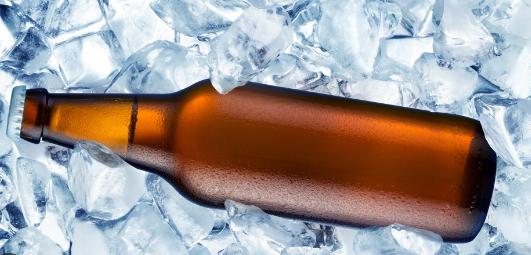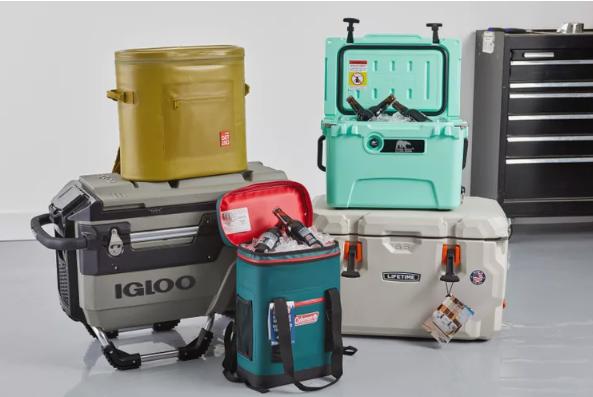Beer is best served cold for many reasons. Its flavor and aroma are enhanced when it’s chilled so that you can enjoy the full taste of your brew.
Cold beer also has a refreshing feeling which makes it more enjoyable.
Also, cold beer is more thirst-quenching than served warmer, making it an excellent choice for consuming on hot days or after physically taxing activities such as exercise.
Lastly, when served too warm, beer can release flavors that can be unpleasant to some drinkers.
Suppose you want to make your beer colder and maintain its great when you drink! We prefer you get the best cooler for beer storage.
Storing your beer in a cooler keeps it cold longer, which is ideal for keeping it at optimal drinking temperature.
A good beer cooler is insulated and can store your beer at the right temperature for longer.
Getting a high-quality premium cooler will also help keep your beer serving at its ideal temperature and protect it from any potential contamination.
The Science Behind Serving Beer Cold
Beer is one of the most popular drinks in the world, and it’s usually served cold.
If you have ever enjoyed an ice-cold beer on a hot day, you may have wondered why beers are best served cold.
After all, why not enjoy your beer at room temperature? There is a science behind why beers are best served cold, which concerns how our taste buds work.
Storage Matters Too
It’s not just about serving temperature; storage matters too! If you want your beer to stay fresh and flavorful for extended periods, store it somewhere cool — around 40°F — until it’s ready for consumption.
This will reduce oxidation which can cause beers to become stale over time if not stored properly.
Keeping your beer in an environment with constant temperature fluctuations can also harm its quality, so ensure that it won’t be exposed to extreme temperatures or direct sunlight).
The Temperature Factor
When served cold beer, its flavor molecules are less volatile and less likely to evaporate into the air before they reach your taste buds.
This means you get more flavors that you would otherwise miss out on if the beer was warmer. Additionally, when beer is served colder, certain aromas and flavors are muted, making it easier for other flavors to stand out.
Serving temperature also affects how quickly we taste the flavors in our beer. Since our taste receptors become less sensitive as temperatures drop, we need to drink beer warmly to experience its complete flavor profile — something brewers are well aware of when they recommend their beers be served cold.
On the other hand, the chill in a cold glass or bottle helps us taste all those subtleties right away, allowing us to appreciate each sip with greater clarity and distinction.
The Flavor Profile of Cold Beer
When beer is chilled, its flavor profile changes significantly. The bitterness from hops dissipates, giving way to more subtle flavors and aromas that can be difficult to pick up when served at room temperature.
In addition, colder temperatures cause carbonation levels to increase in both canned and bottled beer, producing a smoother finish on the palate.
The Carbonation Factor
In addition to temperature, carbonation also plays an important role in how the beer taste. Carbonation can enhance a beer’s flavor profile by adding complexity and depth to the overall taste.
Carbon dioxide (CO2) is absorbed into the liquid during fermentation, creating tiny bubbles of CO2 within the beer itself.
These bubbles help release all those delicious aromas and flavors when you take a sip of your drink. When we serve beer, these bubbles become much smaller and more numerous, making them even more effective at releasing flavor compounds into the air.
The Mouthfeel Factor
Finally, let’s not forget about mouthfeel! Beer has an incredibly creamy texture when served cold because all those tiny bubbles help coat your tongue with flavor compounds as you sip your drink.
Furthermore, colder temperatures make beers feel crisper and more refreshing on your palate than warm ones, which makes drinking them much more enjoyable!
Ideal Temperature For Beer
Drinking beer has an ideal serving temperature range that makes it most enjoyable.
Below are some of the beers with ideal serving temperatures:
- Imperial Stouts: 55-60°F
- Lagers and Pilsners: 40-45°F
- Amber Ales: 45-50°F
- IPAs: 45-55°F
- Light beers 40-50°F
Ultimately, it all depends on your personal preference and the type of beer you’re drinking. Experiment with different temperatures and find which works best for you.
Why Is Cold Better?
It all comes down to how our taste buds perceive different flavors. When we drink a cold beverage, our taste buds become desensitized and less receptive to bitter flavors.
This is why some people can’t stand the taste of black coffee without adding sugar or cream—the bitterness is too strong for their taste buds to handle. But when they add those sweeteners, they can bring out the flavor more quickly.
The same goes for beer—when served cold, the bitterness is less intense, and other flavors like sweetness and fruitiness can be brought out more quickly. This makes the beer easier to drink and much more enjoyable overall.
In addition to making beer easier to drink, colder temperatures also help preserve the beer’s flavor for extended periods by slowing oxidation.
This natural process occurs when air reacts with certain compounds in beer resulting in diminished flavor over time. Oxidation happens faster when beers are stored at higher temperatures, so keeping them as cold as possible helps preserve their flavor.
Related: The Best Foods To Pair With Cold Beer
Conclusion
Beer is best served cold because it helps enhance its flavor while also preserving its quality over time.
Colder temperatures make beers easier to drink by desensitizing our taste buds and reducing bitterness while simultaneously helping slow down oxidation which helps preserve its flavor for extended periods.
No matter what type of beer you’re drinking, it’s always best to experiment with different temperatures and find the ideal temperature for your personal preference. Remember, it’s all about finding the perfect balance between flavor and enjoyment! Happy drinking!
Read Next: 10 Best Cream Ales in the World





